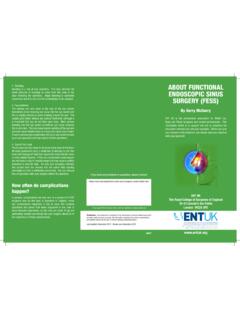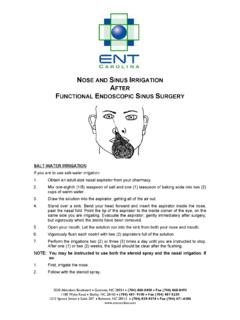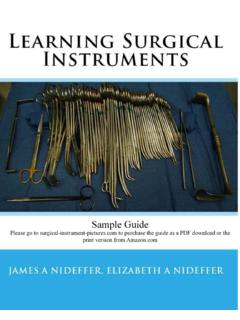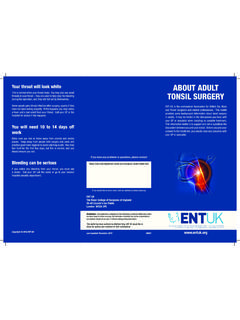Transcription of Post-operative Instructions for Intranasal (Septoplasty ...
1 2006-jad Post-operative Instructions for Intranasal ( septoplasty , Turbinectomy)/ sinus Surgeries (FSS) The following Instructions are based on experience with thousands of nasal operations. They are designed to answer practically every question that may arise regarding the do s and don ts after surgery. You and your family should read the Instructions several times to familiarize yourselves thoroughly with them. Attempt to follow them faithfully because those who do so generally have the smoothest Post-operative course. This, of course, favors proper healing and a better result. Swelling: Every operation, no matter how minor, is accompanied by swelling of the surrounding tissues.
2 The amount of swelling varies from one person to person, but it seems more in the face because the looseness of the tissues makes the features appear distorted. It is usually greater when both the inside (septum) and outside of the nose have been operated on that when surgery is done on the inside (septum) only. Some degree of swelling then follows any surgical procedure. The swelling is due to the new tissue fluids brought into the area by the body to promote healing. The increased blood supply to the region is responsible for the pink color of the skin and discoloration associated with surgery. When these healing fluids are no longer required, the tissues release them and they are absorbed through the bloodstream.
3 As this occurs, the nasal congestion will gradually improve. You must be willing to accept temporary swelling and discoloration which occur following such operations. Most people feel it is a negligible inconvenience to pay for the physical and psychological improvement they experience. The swelling will gradually increase, reaching its peak on the third day. This is not serious and is not an indication that something is going wrong with your operation. Minor swelling may persist for several weeks. The main thing to remember is: such swelling eventually subsides. You can help the swelling subside in several ways: Avoid bending over or lifting heavy things for one week.
4 Besides aggravating swelling, this may raise the blood pressure and start bleeding. Avoid hitting or bumping your nose for at least one week following surgery. It is not wise to pick up small children who may inadvertently bump your nose. Sleep with the head of the bed elevated until all the dressings have been removed from the nose. To accomplish this, place two (2) or three (3) pillows under the head of the mattress and one (1) or two (2) on top of it. Try not to roll over on your nose. We recommend you use ice compresses consisting of moistened cold wash cloths (not an ice bag) applied in an inverted v across the top of the nose and covering each eye as much as possible during the first three (3) days after surgery.
5 2006-jad Avoid sunning the face for prolonged periods for one (1) month; ordinary exposure is not harmful. Do not tweeze the eyebrows for one (1) week. When bathing, avoid getting the nasal dressing wet; if it becomes loose let us know. You may gently blow or sniff your nose the third day after the operation. Do not push on the nose when blowing. Blow gently through both sides at the same time. Avoid constantly rubbing the nostrils and base of the nose with Kleenex or a handkerchief. Not only will this aggravate the swelling, but it could cause infection, bleeding, or the accumulation of excessive scar tissue inside the nose.
6 Use a moustache dressing instead if the discharge is excessive. Report any excessive bleeding that persists after using a nasal spray (Afrin or Neo-Synephrine) and sitting up for 15 minutes. Discoloration: Following surgery it is not unusual to have varying amounts of discoloration about the eyes. Like swelling, the discoloration may become pronounced one (1) to two (2) days after surgery. It usually does not last for more than a week, all the while decreasing in intensity. The measures that help the swelling to subside will also help the discoloration. You can camouflage the discoloration, to some extent, by using makeup. Hemorrhage: You can expect more mucous drainage for several days after surgery and it may be blood-tinged and should cause you no concern unless the drainage becomes bright red and flows heavily.
7 If hemorrhage does occur, go to bed, use a nasal spray such as Afrin or Neo-Synephrine, and elevate the head. Then apply ice compresses about the nose and report it by telephone. Avoid: bending over, lifting heavy objects or hitting your nose. Pain: There is usually only mild to moderate pain following nasal and sinus surgery but the individual may experience a bruised sensation as a result of the Post-operative swelling. As is usually the case with such things, this seems worse at night and when one becomes nervous. Try the application of cold compresses. If this is not effective, you may take one of the pain relievers prescribed for you.
8 Head and Neck Surgery Associates 2006-jad Post-operative Instructions for Intranasal ( septoplasty , Turbinectomy)/ sinus Surgeries (FSS) During the healing process, you may experience occasional sinus headaches. These may occur up to several weeks after surgery. They will gradually disappear as the healing process continues. Nasal Blockage and Nose Sprays: Nasal blockage is to be expected after nasal surgery and will gradually subside over a period of time. The patient must reconcile him/herself to this. Nose sprays such as Afrin or Neo-Synephrine may be used for several days if recommended by your physician. Cleaning the Nose: Don t blow the nose at all for three (3) days; after that, blow through both sides at once do not compress one side.
9 You may clean the outside of the nose and the upper lip with cotton-tipped applicators (Q-tips) moistened with hydrogen peroxide as soon as you return home, but don t rub too vigorously. Dried blood in the nostrils may be gently cleaned and removed with a Q-tip. Vaseline or an antibiotic ointment may be applied to the inside of the nostrils and the outside incision if your physician specifies this. The Vaseline helps soften crusts and usually make the inside of the nose feel better. This may be continued for several weeks. Resume Activities: You may sleep without the head of the bed elevated after two (2) weeks. You may resume physical activity in two (2) weeks.
10 No swimming, gym, tennis, jogging or other strenuous athletic activity for four (4) weeks. No diving, skiing or contact sports for two (2) months. Try to avoid sneezing. If you must; let it come out like a cough through the mouth. If it becomes a real problem, we will prescribe medicine to alleviate the condition. As long as the shape of the nose has not been altered, glasses may be worn as normal. Contact lenses may be inserted the day after surgery. Dryness of the Lips: If the lips become dry from breathing through the mouth, coat them with Vaseline or Chapstick. Temperature: Generally, the body temperature does not rise much above 100 following surgery, and this rise is due to the fact that the patient becomes mildly dehydrated because he/she does not drink enough fluids.









